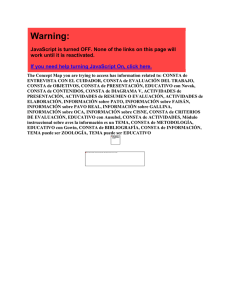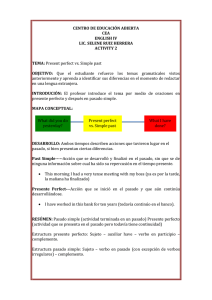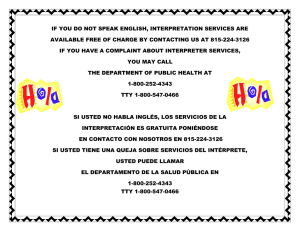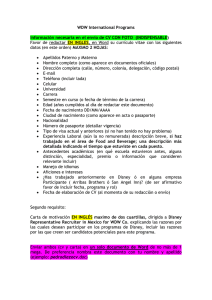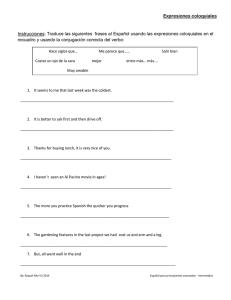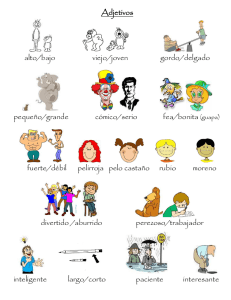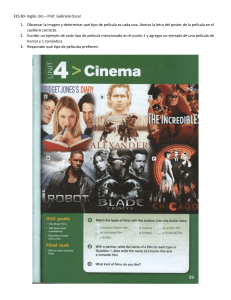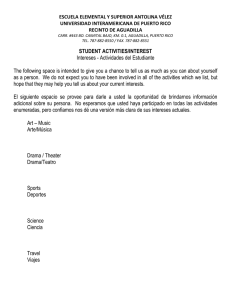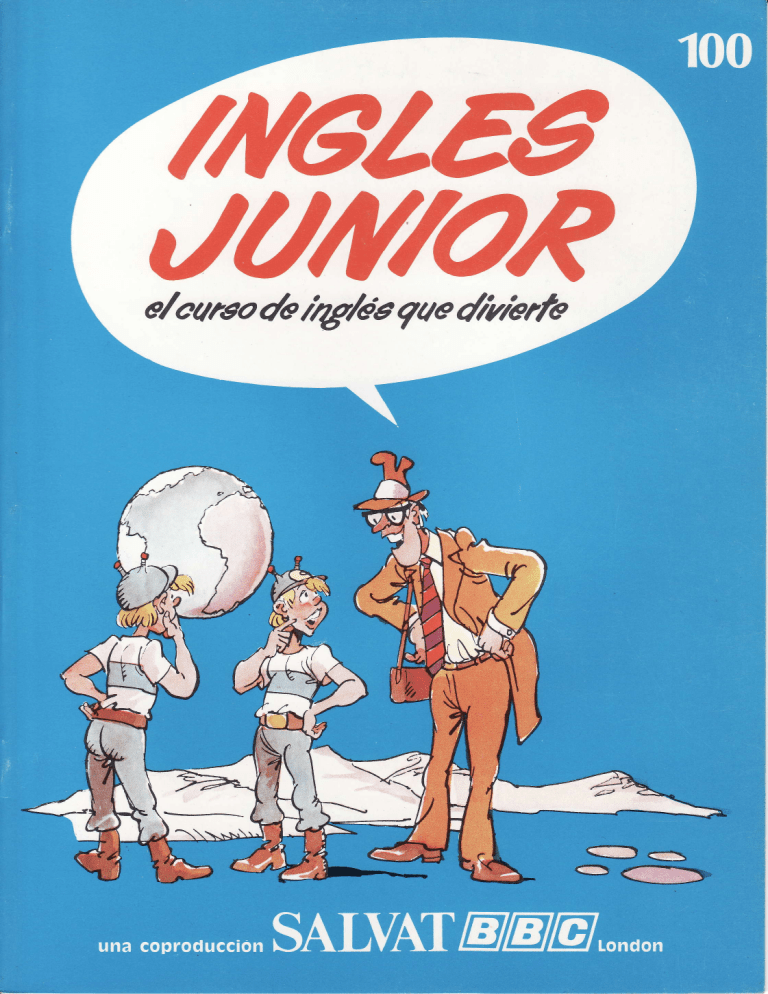
C Ó MO U TILI Z A RE S T ECURS O
UNIDA DE SIMP A RE S
1l Mirad la primera página. Es una introducc¡ón a lo que va a desa¡rollarseen la
unidad, y os dará a conocer algunas expresiones inglesas que se utilizarán en
ella.
2) En fa página Do you remember2 encontraréis atgunas expresiones aprend¡das
en la unidad precedente. Mirad la ilust¡ación y leed las expresiones.
3l Practicad las Language activities. Se componen de imágenes, rimas para la
pronunciación, rompecabezas y juegos; las instrucciones se encuentran en
cada página. Muchos de estos ejercicios van acompañados de preguntas grabadas en la cassette; cuando se dé este caso, mirad la página correspondiente, escuchad la cassette y responded a las preguntas. Seguidamente, haced
prácticas s¡n la cassette, respondiendo a preguntas que pueden ser foimuladas por un compañero.
4l Escuchad la canción grabada en la cassette, mirad el texto y la ilustración, y
aprended a cantarla (si queréis tocarla a la guitarra, encontraréis la part¡tura
en la misma páginal. Volveréisa oír la m¡sma canc¡ón en el comic.
5) Seguid fas instrucciones de How to make it? y practicad las expresionesinglesas con el objeto que habré¡s construido.
6) Mirad la página de Words & Phrasesy practicad con ellas. Son palabras y expresiones que ya han sido utilizadas en la unidad.
7) En las páginas centrales hay otros rompecabezas, objetos para construir y
posters que podéis separar.
UNIDA DE S P A RE S
1l Mirad la primera página, leed las expresiones de la página Do you remember?
y practicad las Language activities como en las unidades impares.
2l Mirad las imágenes del comic. Después escuchad la cassotte sin mirar las
imágenes: haced lo posible para comprenderlo que estáis oyendo. Seguidamente, mirad el comic y escuchad, al mismo tiempo, la cassette. Podéis cantar las canciones, repetir lo que los personajes dicen, hacer algunos dibujos
reflejando lo que ha sucedido en el com¡c y escribir algunas frases en inglés.
3l Realizad los ejercicios de escritura.
4) En las páginas centrales encontraréis un diccionario ilustrado que podé¡s separar y coleccionar.
No ofvidéis que las páginas de Language activities os ayudan a ejercitar diversos
aspectos de la lengua inglesa, y que d¡chos aspectos se repasan en los comics de
las unidades pares oyéndolos rodeados de otras expresiones. Recordad también
que, siempre.queos sea posible,debéis practicarcon vuestrosfamiliaresy amigos las expresiones inglesas que aprendéis.
UNITR
IOO Fq
Cffi!
VE,RV
acr¡OIVERV
--5'@g*-
Mr. Barrettlooksvery happy.Why?What is he reading?ln the story,we'll see...
100/ 1
ER?:
DOIOI'
Lookat this picture,and you will seesomeof the wordsfrom Unit 99.
Have vou been here before?
2---L
-.*
--::
N
-*--.
*v¿
ú
¿É
a
me. Could you tell
$excuse
qme
the wav to the castle?
//E.#-;;w\
*-7[
on until you come to a.
5nr
EEtltrtrc
lneo
ZÁaq
ffi
I ¡orner ANDTHE'm@om
nffimrc'
Atour r
1HráONE?
YÉA.AWÍü
Col,lE,
tEl
lHfOYloRNl
HAVE
$EVIREATLABOUTNE
QRd6IMI NAÍ,
]IIEYIRE
ANP
ALL
NE
YE6.E\lERtt
-r |IIM.EVERVONE
ll{)t6lrr Hl,|'/i,A6
\ERY@OD.
Ar¡e
1l{r5citL:Hl6&/Ke
|6'IIIEFUNIÜE
T rcKE
A}DHEbIIIE
áil68RrryE
AI.9THI6ON¿.
I'NoRMAN
64f16
(¡}I
VERY
WELL.I
AflLLHARHI6
6M tNMVr{EAD:l
100/3
100/4
HÉA6KP }IIIA
T)@IN]HE
ct?ctJo.
DERI.IARD
6RÉgN.
RER,RIER'
1'I'14
I IPRKTSRfHE
" ¡/'l@NNeWá'.
A
WELL,l'M
RE,R2KIER.
REFSRÍER6
KNOqJ
At.of
oFlHlN66.,.
\eRV
I f}{ou6|{fHeWAO
@D,AI6 TOKEWAO]HE
FUNNTEáT
AC/KE
f'Ue
I{EAR9.
f IAIJ6HED
EVEK
I.AIJ6HE,P.AND
INTI{E
YT6. f 6A\lJNORIT1AN
Nl6llT All0
a"a6u6f
10
I.D LIKE
INlHE
I{IM
,.MOON
¡
, NEWái
\
}IAVE
6EEN
YOU
MME'á WELL.'
WELL,YOI,R,
you
'TGREENU,AND
IAIJGHED
UNT1L
)OURÉCE
lü\,¡óURED':
Mr. Greensaw Norman ¡n the circus,
And thought he was very good.
He sent a telegram to Mr. Barrett,
Becausehe thought Norman
was very very good.
'l laughed until my face was red.'
That's what Mr. Greensaid.
IbW,MR.DARRE]T.
HMM.
DI' YdJ6ET
MV
1 0 0/ 6
u'RlrÉA60tT \HI€ @I(EWA€
\eo.l'o LIKE'Tl2
zore l'vE Fl
tlE\iEn15A\ll
I{IMINT}IE
YE-E-6,t{E...l{E
WA6VERY
lááT Nt6lff,
WAáN'T
}IE?
AN9
\ffi,1¡IAU6I{ED
tNIA¿f, I
IAu6l{ED...
YE6.AltD...He,6 A VERy
IAIJ6T{ED,..UNtrIL
o|{L... MR.6REEN
HE-!
áIN6EF,l5N5
t4l6FAC?W¡á REP...
\}¡IiOTAU6HTl{tl'l1i3AN67
YE6.V'll{OTAJGlff
TOAN,6lI'14
HIM
AJREIIEII¿DA
At{I1áEE-.\t
rcÜ' WA6N;
ff WAáN'T
F!.!:-IMUE
l{R.AARRÉTT?
ER...flcl.Nor('*
-z-=-.,:l
ff
n UJA6NTI'18.
aEilotl.6olotloN
vEFy6ooP
YE€,l'D UKEANlÑfEtsviÉuJulffl{ }urR[tAN,AND
Mr. Green has come to see Norman,
He's going to write about him
in the'Moon News'.
Mr. Green -the reporter- has come
to see Norman.
He wants an interview
With Norman.
He wants an interview.
100/7
10 0/ B
zuf I 90NrT
LIKECAEE6E,
watbe yourvE
couEfa
]T{ECtzuá
6rEnrfb f.bf
I MUár
tsErcRErAND á-lrr MAl.lNOW.
NEVER
IAJ'VE
Mr. Green has come to see Norman,
He's going to write about him
in the'Moon News'.
Mr. Green -the reporter- has come
to see Norman.
He wants an interview
With Norman.
He wants an interview.
A
ER...WIüT
Nrhlf¡ñ/lEtrt?
100/9
ER...'A(A
NORIü1AN...A
A LFüE
MoRE...ÍU6r
A LIfTtE
MffiÉ...
1 00/ 10
tANffiEffiTIES-
I
When you have listened to the story, answer
these questionsabout it.
Answers on page 16.
1. "A lot of telegramshave come this morning.
They'reall about Norman."
Who said this? .
2, "l'm a reporter.I work for the 'Moon News'."
Who said this? .
3. "l laugheduntil my face was red."
Who said this? .
4. "He was a terrible singer. But I gave him
some lessons,and now he's very good."
Who saidthis? .
5. "You've never taken a photographof me!"
Who saidthis? .
6. "Back a little, Norman. Back a little more."
Who said this?
100/ 1 1
tANffiE
What' s th e na me o f Mis s Peel' s hot e! ?
ESA n s w e r s o n pa g e 1 6
Seguid con el dedo lasindicaciones dadas en el recuadro y escribtdlas letras a medida que las encontréis. Obtendréis el nombre det hotel donde se encuentra Miss Peel y podréis contestar a la pregunta. (Os damos la primera letra como ejemplo. )
Go until you come to the letterA.
Take the first turning on the left and go on until you come to the letter, .
Turn left and go on until you come to the letter . . . ' .
Take the first turning on the right and go on until you come to the letter.
Turn right and go on until you come to the letter. ' . . .
Take the next turning on the right and go on until you come to the letter
Go back and straighton until you come to the letter' . ' .
Turn right and go on until you come to the letter. . . . '
Turn right and go straighton until you come to the letter.
. . . Hotel.
lt's the
What is the name of Miss Peel'shotel?
100/ 12
What have they bought?
,a",
Janet and Robin have bought some things on
the shopping list. But they haven't bought the
other things yet. Look at the example in the
box. Can you go on?
Las cosasmarcadascon elsigno (V)son lasque
Janet y Robin ya han comprado.
They've bought some butter, but they
haven't bought any cheese.
A nswer s on pa ge 16 .
100/ 13
on p:ge16.
Answers
l
HOW TO GET TO
Leed las indicaciones gue da John para poder
llegar a su casa. ¿Podéis escribir las instrucciones para llegar a la casa de Martin (plano 2) y a
la de Jill y Nickv @lano 3)? Os pueden ayudar
las indicaciones gue figuran en las páginas I y I
de Ia unidad 99, así como las de las unídades
43, 6l y 83. Necesitaréis las expresiones que
aparecen en el recuadro100/ 14
M ARTIN'S HO US E
the firstturning
. I rioht
ontn" r"it
I
bridge
church
H OW TO GE T TO JILL A N D I\IIC K Y ' S H OU S E
turn left
right
bottom
at the I
toP
{
past
next to
crossroads
roundabout
shop
caté
traffic lights
bus-stop
Answerthis question:
'Can you tell me the way to
your house?'
Write some directions.
Write these words first:
HOWTO GETTO MY HOUSE
-and then write the d¡rections.
100/ 15
PAREI{TS'PAGE
S ong.
I've never seen
anyone as funny
as Norman.
Allegrettorubato( J:1
201
as Nor-man ,
pke
m,
rs
lhe
'Hes the bestsing
lun - nl
Bi
ffi
Indicaciones
Página 1.
Página 2.
ffi
flT[-f{n
[T[n-t
[fl-Jt,
I ta ta -
fffTfl
rm
referentes a las páginas de la presente unidad
Página de introducción que anticipa los acontec¡mientos que
se desarrollaránen la h¡stor¡ade la presente un¡dad.
Rev¡s¡ón de los principales puntos aprend¡dos en la un¡dad
anteflor,
Páginas 3-10. Versión en forma de com¡c de la h¡storia grabada en la
cassette. En ella se prosigue el estudio del present pertect,
i l E tl
t-/----r-l
uno de los principales puntos aprendidos en las tres unidads
precedentes (vea la página'16 de la un¡dad 98, donde se indican las normas para la formación de este tiempo y su sentido).
La h¡stor¡a presenta varios ejemplos del empleo del present
perfect para des¡gnar acontec¡mientos pasados, sin especificar
la fecha en que tuvieron lugar. a saber:
Have you seen lgor today? - No, I haven't seen him today.
I'm sure l've heard that name before.
y para designar acontec¡mientos cuyos efectos se manifiestan
en el presente, a saber:
A lot of telegrams have come th¡s morning.
l've come to see Norman.
Aparecen algunos ejemplos con el empleo del adverbio never.
que ha sido introducido en unidades anteriores,a saber:
l've never seen anyone as funny as Norman,
You've never taken a photograph of me.
El adverbio ever se emplea igualmente, en especial en fras€s
como las s¡guientes:
... the best singer I've ever seen.
... the funn¡estjoke l've ever heard.
Como se ha indicado en la página 16 de la unidad 98, no deoe
confundirse el present perfect con el pretérito, por ejemplo:
I saw the circus last n¡ght.
He spoke to him lasr night.
He aquí dos nuevas observaciones relativas al present perfect:
a) El nombre que se da a este tiempo puede crear confusiones
ya que, a pesar de llamarse present p6rfect. se emplea para
haeer referencia a acontecim¡entos que han tenido lugar en
el pasado {en español se llama pretér¡to perfecto). Si se denom¡na present perfect es porque el acontec¡miento pasado está de alguna forma relacionado con el presente (por
e¡emplo, su efecto puede ser obseruado desde el presente,.
-nar s
what
the
D Al estud¡arla formaciónde este t¡emoo.se ha señaladoel
empleo del part¡cip¡opasadodel verbo que se conjuga.
Cuandoapareceun verbo ingléspor primeravez, es muy
!trl aprender sus formas: arrive-arrived. buy-bought,
speak-spoke-spoken,
etc. (dosformassi es regular,y dos
o Íes si es irregular:infinitivo,pretéritoy partic¡piopasado).
P ági ru.!1. E €rci .l o de comprensi ón
basado,como es hab¡tuale, n l os
acor:9.i mi entos
quehanten¡dol ugaren l a hi stori a,
Págie 12. Eir:r¡;s 6ed¡..6. a la con.iunción
unt¡|, a las expres¡ones
emD€acaspa€ ;nd¡caruna direccióna seguiry a algunasletras.
Pá9im 13- Re'tisióncei prsent perfect (have bought), así como de los
D-onombres
irdefinidossome/any y del vocabulariorelativoa
.acomd€. Obsere que los inglesesempleanel signo ll/) para
rad¡carque una cosaes correctao que ha sido realizada,
y el
signo t pnraindicarlo contrario.
'/
Págires 14-15. Ejerciciode redacc¡óndedicadoa las exoresionesempieadasparaseñalaruna direccióna seouir.
ANSWERSTO PAGE 1'l: 1. Mr. Barrett.2. BernardGreen,3.
Bern¿¡dGreen.4. Solomon,5. Mr. Barrett.6. BsrnardGreen.
ANSWERTO PAGE 12: lr's the ARMSTRONGHotet.
ANSWERS TO PAGE 13: They've bought some salt; but they
haven't boughf any bread. They've bought some sausagesand
they've bought some eggs. They'v€ bought some flour, but they
haven't bought any sugar.They've bought som€ p€aches,but they
haven't bought any apples.
ANSWERS TO PAGES 14-15: Deberíaishaber escrito unas frasesparec¡dasa las siguientes:
2. Get a number 21 bus to North Road. Get off at the bus-stop.
Go (Walkl past the church on the left, and take the second turning
on the r¡ght.Then turn left. (Thentak6 the first turning on the left.l
Tha:'s Martin's street. He l¡vesat number 3. 3. Go stra¡ghton until
yqr come to a ¡oundabout.Tum right at the roundabout,and go
stra¡ght on until you com€ to a crossroads, Turn left at the cross¡oads. Then go stra¡ght on. Go ov6r a bridge and take the first
turning on the right Jill and Nióky's house is on the left, lt is near
the b¡g house.
Palabras que aparocen en el com¡c
back a little: ve un poco hacia atrás back a litde more: ve un prco más hac¡a atrás. did you get my
teleg.am?: ¿ha rec¡bido usted mi telegrama?. havo we m€t befo.e?:
'
¿nos
hemG eocontfado antes? ¡'vo n6var sogn anyone as lunny as Norman: no he visto nunÉ a nad¡e tan gracioso
com Norman . I can st¡ll hgar his song ¡n my hsad: puedá oír
'
todavía su canc¡ón en mi cabeza tes como si gyera todavia su canc¡ón) . that's what the telegrams said:
eito es lo que decían los telegramas
100/ 16

